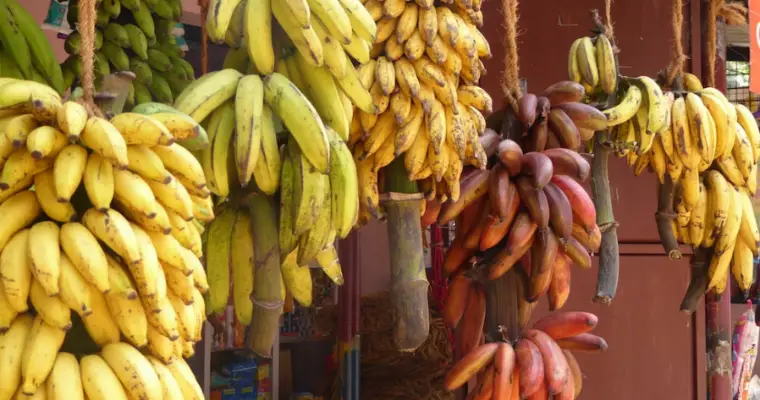Interesting Facts on Bananas: Part 1

Interesting Facts on Bananas Part 1
Bananas, the tropical fruit with a distinctive curved shape have gained immense popularity worldwide. Not only are they a convenient on-the-go snack, but they also offer a wealth of culinary possibilities.
In this blog post, we will delve into the origin of the humble bananas. As we, explore the different types widely used today and highlight some various uses of bananas in our everyday lives.
Additionally, in Part 2 we will conclude the series with Plantaful Life’s delicious plant-based recipe for “nice cream” a real crowd favorite!
Peel and Enjoy the Banana Fruit Benefits

From Origins to everyday Delights
Bananas have a long and fascinating history. The fruit was believed to have originated in the region that comprises Malaysia, Indonesia, and the Philippines.
As trade routes expanded, bananas gradually spread to other parts of the world, eventually reaching Africa, Europe, and the Americas through various explorations and migrations.
Today, bananas are grown in over 150 countries, making them one of the most widely cultivated fruits.
Bananas Consumed in the United States
In the United States, there is a wide range of banana varieties commercially available, each with its own unique characteristics and culinary applications.
Today, the most common type of banana found in supermarkets is the Cavendish banana. There are many other varieties that cater to different tastes and preferences, we will introduce you to a few of the most popular.
Banana’s History
The Gros Michel banana was once the dominant and widely cultivated banana variety before the emergence of the Cavendish banana.
Understanding the significance of the Gros Michel banana sheds light on the history and challenges faced by the banana industry still today.
The Gros Michel banana originated in Southeast Asia and gained popularity in the late 19th and early 20th centuries.
It quickly became the preferred commercial banana due to its rich flavor, firm texture, and resistance to transportation.
However, in the 1950s, the global banana industry faced a devastating blow when a strain of Panama disease, caused by the fungus Fusarium oxysporum, wiped out large plantations of the Gros Michel variety.
Panama disease, specifically Fusarium wilt, affects the vascular system of banana plants, obstructing water and nutrient flow and ultimately leading to plant death.
As a result, efforts were made to find a replacement banana variety that could resist the disease.
The Cavendish banana, which was less susceptible to Race 1 of Panama disease, emerged as the alternative to the Gros Michel.
Gros Michel Conclusion:
In conclusion, the Gros Michel banana played a crucial role in the banana industry before succumbing to Panama disease.
Its decline paved the way for the rise of the Cavendish banana, which has become the predominant commercial variety.
The story of the Gros Michel serves as a reminder of the ongoing battle against plant diseases and the importance of genetic diversity in sustaining the banana industry.
Let’s explore Interesting Facts on Bananas popular in the US:
Plantain: A larger and starchy variety of bananas that are commonly found in Latin American, Caribbean, and African cuisines. Unlike the Cavendish banana, plantains are typically cooked before eating. They are often used in savory dishes such as stews, curries, and as a side dish when fried or boiled.
Red Banana: Red bananas have a unique reddish-purple peel and a creamy, sweet flesh. They are slightly smaller than Cavendish bananas and have a distinct flavor with hints of raspberry.
Red bananas are delicious when eaten fresh, and their vibrant color adds a visually appealing element to your fruit salads and desserts.
Manzano Banana: Known as the Apple Banana, kin to the Hawaiian Apple Banana; the Manzano banana is a smaller variety that offers a tangy flavor reminiscent of apples. It has a thick skin and firm flesh, making it ideal for grilling or baking in recipes.
The Manzano banana adds a delightful twist to smoothies, fruit salads, and even savory dishes like salsas and your homemade chutneys
Baby Banana: As the name suggests, baby bananas are smaller compared to traditional bananas.
They are often about half the length of a regular banana and have a sweeter taste. Baby bananas are a convenient snack, easy to peel and are popular with children.
Burro Banana: Burro bananas are medium sized with a squarish shape and bright yellow peel.
They have a tangy flavor and a firm texture when ripe, making them suitable for both cooking and eating fresh.
Bananas for food?
These are just a few examples of the Interesting Facts on Bananas with 1000 diverse banana varieties available in the world to choose from.
The Cavendish banana remains the most commonly consumed in the United States. However, exploring and experimenting with different types of bananas can introduce exciting flavors and textures to your culinary creations.
So, the next time you’re at the grocery store, consider venturing beyond the familiar Cavendish and give other delightful banana varieties a try.
Closing thoughts:
In closing, Bananas have undoubtedly secured a significant place in our everyday lives. Whether enjoyed on their own, incorporated into a variety of plant-based dishes, or used for their numerous health benefits, bananas offer a delicious and nutritious addition to any diet.
Stay tuned for our The Versatile Banana Part 2 which includes our Banana ‘Nice Cream” recipe….
Be sure to sign up for your > Free 12 Tips Food Guide <
Cheers,
Plantaful Life Team
Disclaimer: The information shared in this blog post and on our website is for educational and informational purposes only. We are here to inspire and support you on your plant-based journey. However, always prioritize your health and consult with your trusted healthcare provider for personalized advice.